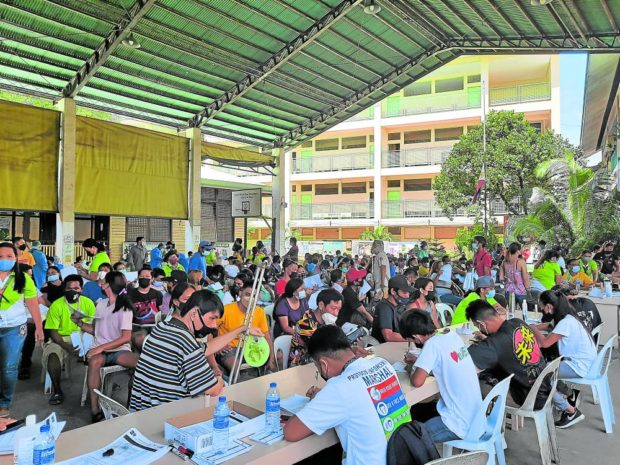Gov’t vaccinates 9.9 million despite local problems

JAB RUSH Residents of Cebu City wait for their turn to get their COVID-19 vaccine shot at Barangay Tisa National High School during the government’s three-day national vaccination drive this week. —NESTLE SEMILLA
MANILA, Philippines — The government has finally hit its scaled-down target of inoculating 9 million Filipinos after extending its National Vaccination Days, but local officials who implemented the program reported a host of problems, particularly in small towns and provinces.
For the Department of Health (DOH), the program was a “huge success” because the government was able to administer 9.9 million doses, or 900,000 more than the target.
The total was also 1.9 million more than the 8 million who were vaccinated from Nov. 29 to Dec. 1.
“Our national vaccination day was a huge success. We were targeting 9 million individuals to be vaccinated. As of [Friday], our tally was 9.9 million,” Health Undersecretary Maria Rosario Vergeire said at the Laging Handa briefing on Saturday.
Presidential spokesperson Karlo Nograles noted during a radio interview that there were problems that arose during the National Vaccination Days, but improvements would be made for the second round from Dec. 15 to Dec. 17.
Article continues after this advertisement31 provinces hit 50% target
But Marinduque Gov. Presbitero Velasco Jr., chair of the Union of Local Authorities of the Philippines, said local governments still have several problems to overcome.
Article continues after this advertisementOf the 81 provinces in the country, Velasco said in another radio interview that only 45 failed to hit at least 50 percent of their target number of doses to be administered from Nov. 29 to Dec. 1.
Only 31 provinces managed to hit their goal of vaccinating 50 percent of their populations, although six provinces—Ilocos Norte, Ilocos Sur, Batanes, Siquijor and Camiguin—were able to surpass their vaccination targets, Velasco said.
Lack of vaccinators
“[Local governments] had different reasons, but the problem for lower-ranked [local governments] was they had insufficient number of vaccinators. Because, in the first place, they lack doctors and nurses,” said Velasco, who is also president of the League of the Provinces of the Philippines.
“That’s why we requested for more vaccinators from the [DOH] and the NTF (National Task Force Against COVID-19) … They were able to send some but we really need a lot of vaccinators,” he added.
A few days before the start of the vaccination on Nov. 29, the NTF said they were still lacking volunteers to man the thousands of vaccination sites to be set up.
Carlito Galvez Jr., chief implementer of the NTF, said they needed 50,895 more volunteers out of the 160,000 nationwide volunteers they were supposed to mobilize.
The government also then needed to set up 5,072 more vaccination sites to complement the 6,039 active vaccination sites.
Galvez said the government had only tapped 17,242 volunteers and 30 teams of the Armed Forces of the Philippines to be assigned in geographically isolated and disadvantaged areas.
Velasco said local governments had no problems with the supply of vaccines as there were more than enough doses, but several local governments reported they were short of syringes to be used in vaccination while a few faced problems with constituents preferring specific vaccine brands.
The national government aims to fully vaccinate at least 54 million Filipinos by the end of the year.